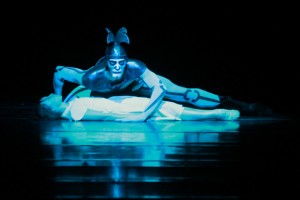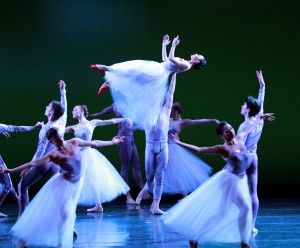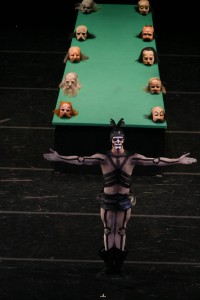“To express your human spirit is a beautiful thing,” Ashley Wheater said in a pre-taped, pre-show video last night before the opening curtain of The Joffrey Ballet‘s fall program at the Auditorium Theatre. As artistic director of the company, he’s tasked with creating an environment for the dancers and audience to grow, learn and thrive. With Human Landscapes, he succeeded immeasurably. The three works on the program span nine decades and range from minimalist German expressionism to modern contemporary ballet and pushed the dancers and audience beyond their comfort zones with resounding success. The Chicago Philharmonic, under the direction of Joffrey Musical Director Scott Speck, added pitch perfect timbre to the contemplative tone of the evening.
As the curtain opens on Jirí Kylián’s Forgotten Land the dancers all face upstage looking out over a dark, but beautiful set designed by John F. Macfarlane, inspired in part by an Edvard Munch painting of women on a beach. The sound of wind, which is actually Kylián blowing into a microphone, alludes to turbulent times and the turmoil of loss. Couples in muted colors (black, red, gray, biege, pink and white) ebb and flow in duets, trios and sextets to music from British composer Benjamin Britten. Each color has its own mood and tempo for movement. A beautiful trio of women end the piece on a somber note.
James Kudelka’s Pretty BALLET, orginally created for the Joffrey dancers in 2010, elicited audible wonder from the audience with its opening tableau. amidst a white fog, Miguel Angel Blanco holds Victoria Jaiani in a horizontal overhead lift as if she’s a puppet waiting to be set free. The long, white tulle skirts on the women are a nod to classical “white” ballets, and aside from a lovely pas de deux by Jaiani and Blanco (where Jaiani, again puppet-like, exits walking en pointe as if a blind or in a trance), that’s all that is pretty here. Women run and circle like demented Wilis, while men march across the stage with forceful battements and fisted hands. Kudelka (on video) said that “ballet is going through an interestingly rough time”. His take in Pretty BALLET shows that ballet doesn’t have to be pretty as long as it’s good – and this is, although the group sections weren’t as tight as in 2010 and could use some cleaning.

Joffrey Ballet dancers Fabrice Calmels and Anastacia Holden in Kurt Jooss' "The Green Table". Photo by Herbert Migdoll.
The most exciting work on the program was Kurt Jooss’ 1932 anti-war ballet The Green Table: A Dance of Death in Eight Scenes. A green table surrounded by “the Gentlemen in Black”, diplomats and politicians, argue about the prospect of going to war. The answer comes as the ten “men” pull out pistols (loaded with blanks) and fire them into the air. In the following six scenes “Death” – in a stellar performance by Fabrice Calmels – is a foreboding, always present presence. He lurks in the background only to swoop onto a battlefield or village and take life, casually, violently and compassionately. The scene where he takes the life of “The Young Girl”, the wonderful Anastacia Holden, was both heart-wrenching and beautiful. Interwoven through the scenes is the Charlie Chaplin-esque character “The Profiteer”, danced brilliantly by Temur Suluashvili. The ballet ends as it began with another meeting at the table, a nod to seemingly perpetual war. Dancer Erica Lynette Edwards said it best (again, from the video), “stillness speaks volumes”. The moments of stillness, of holding a simple gesture, were the most powerful.


